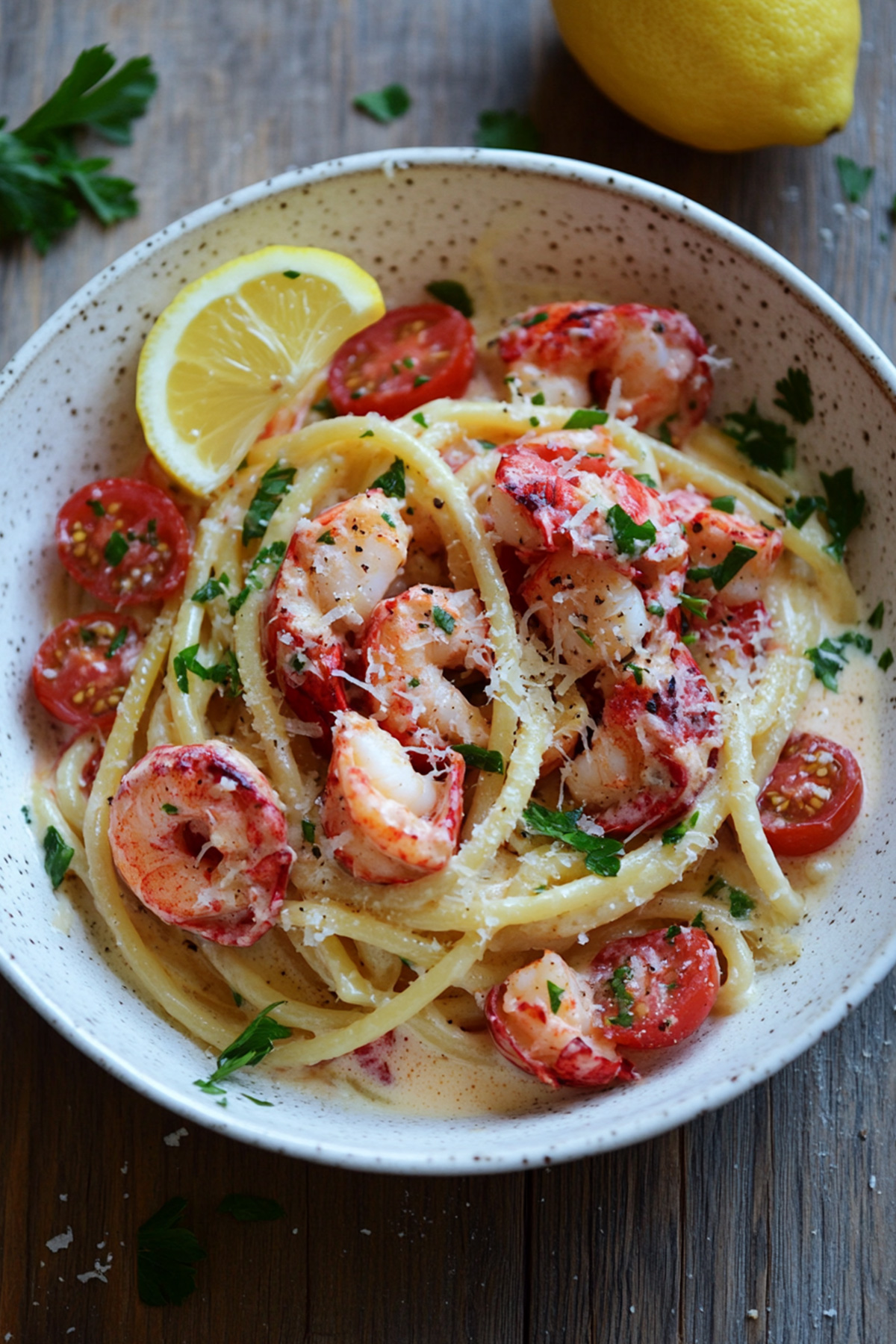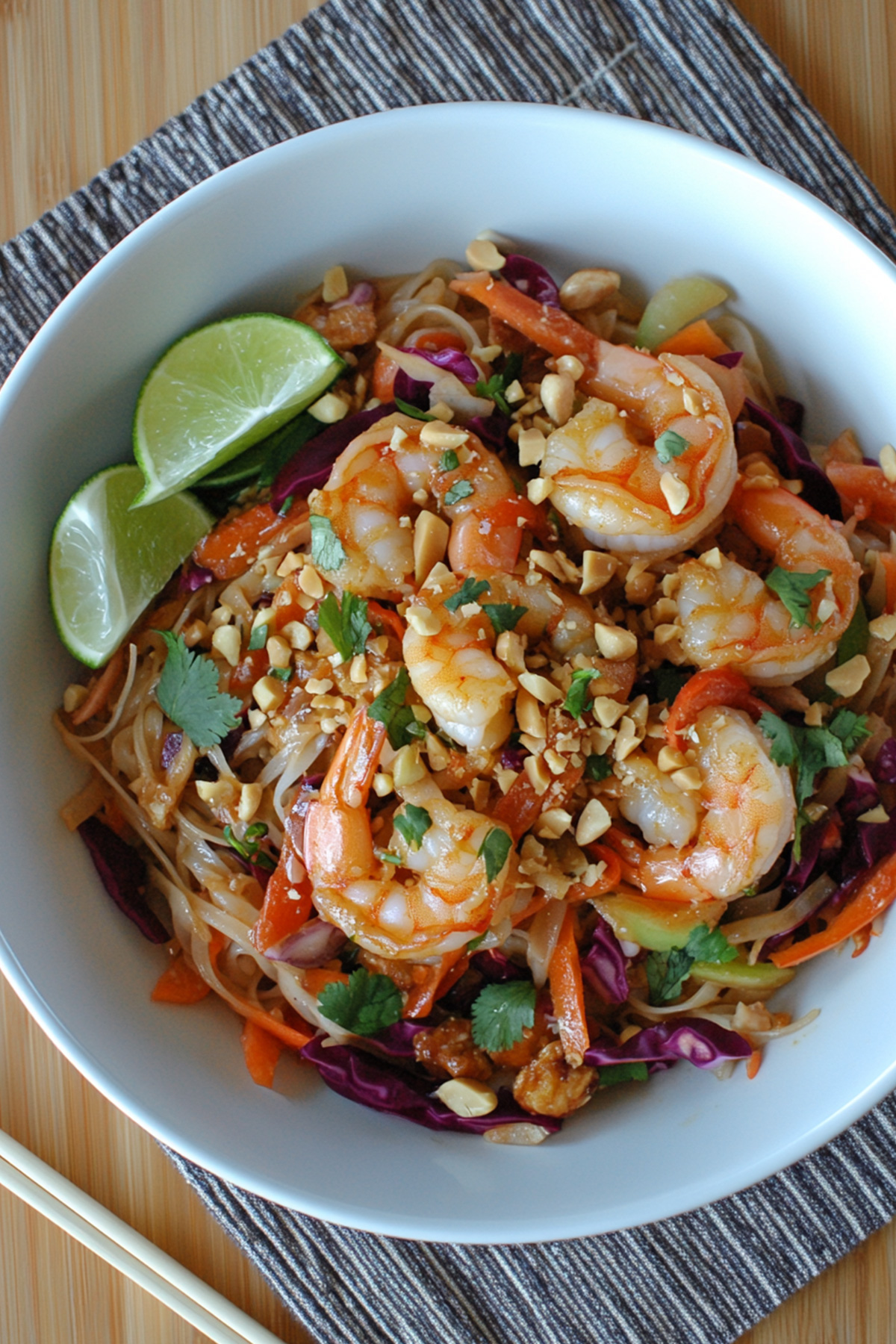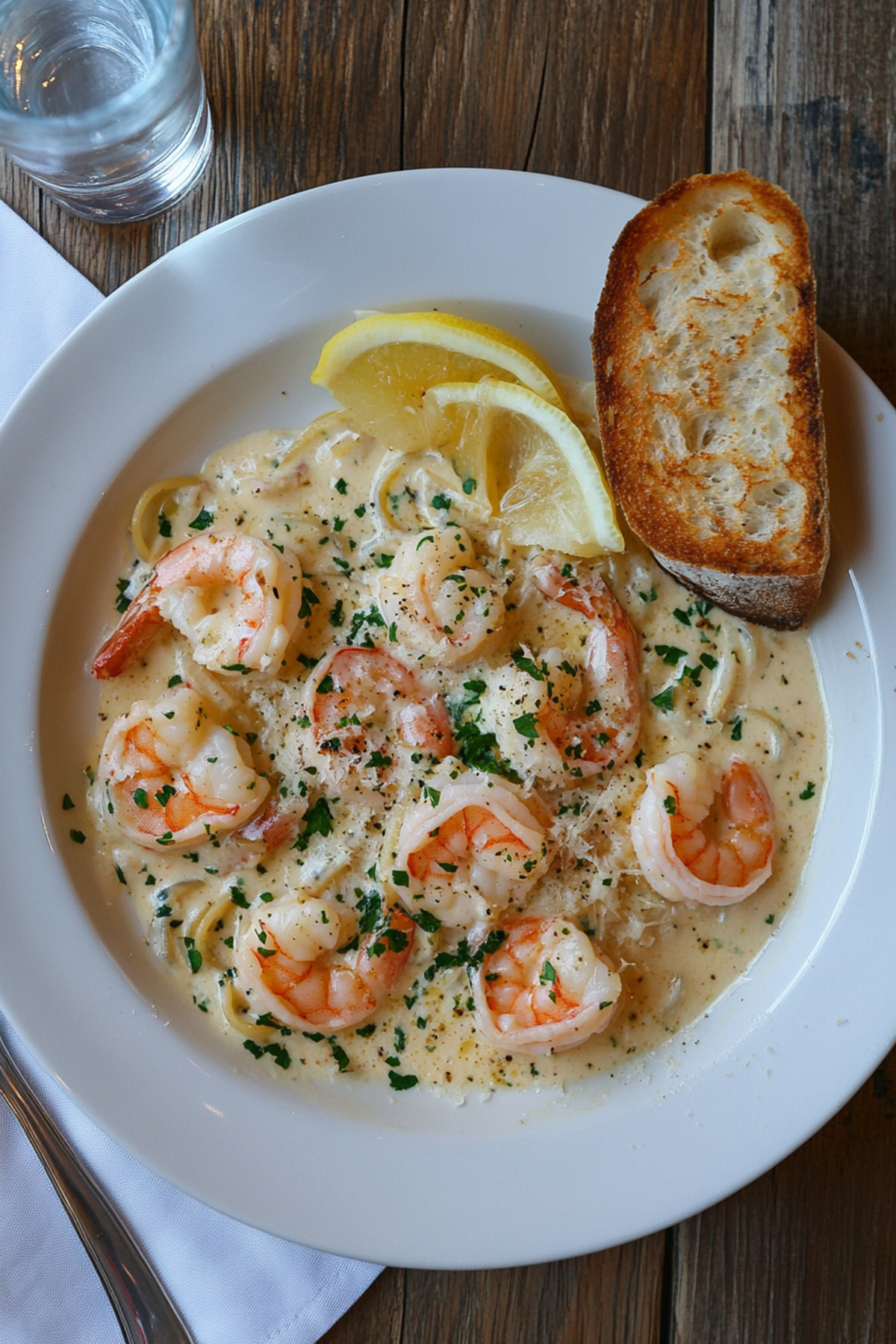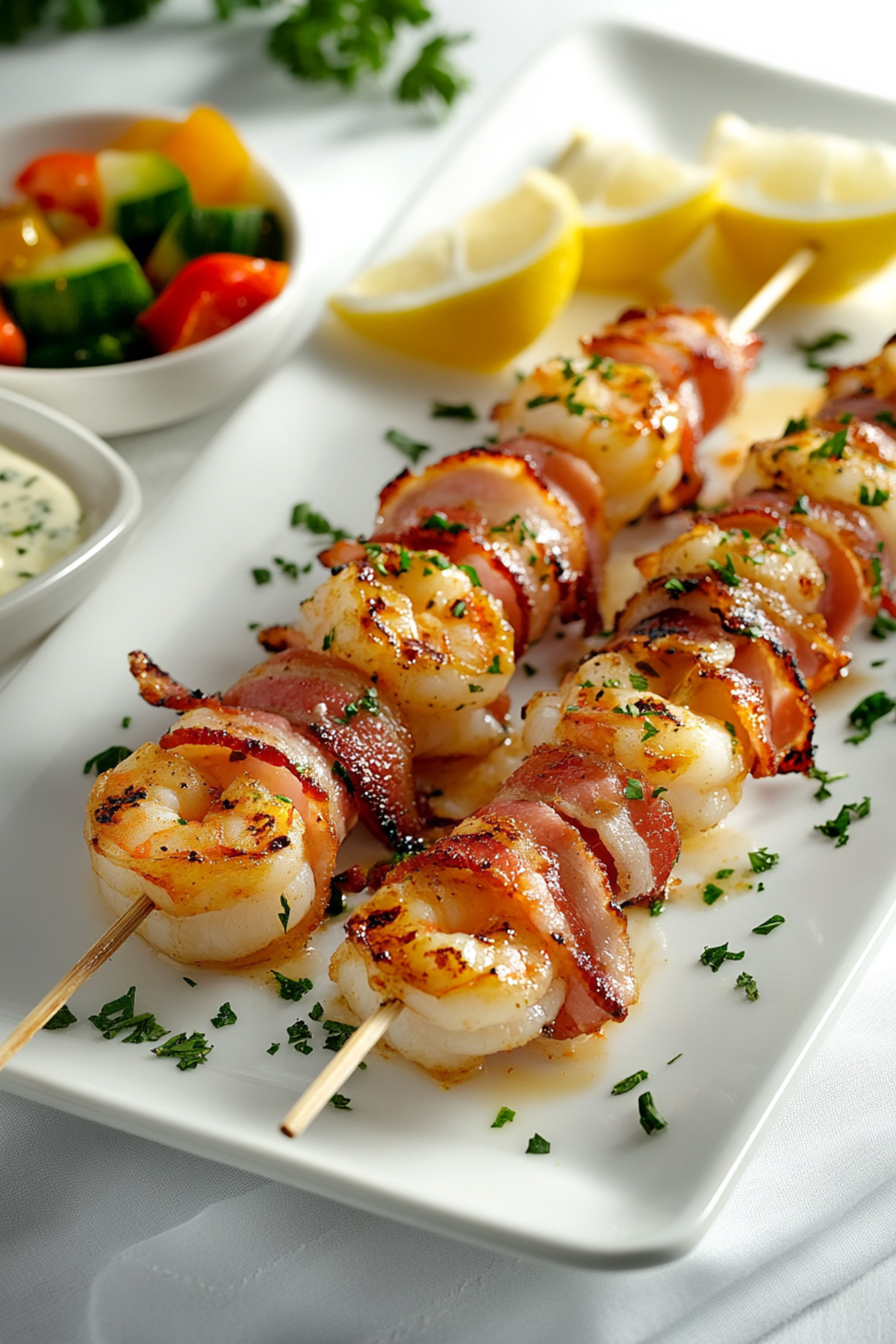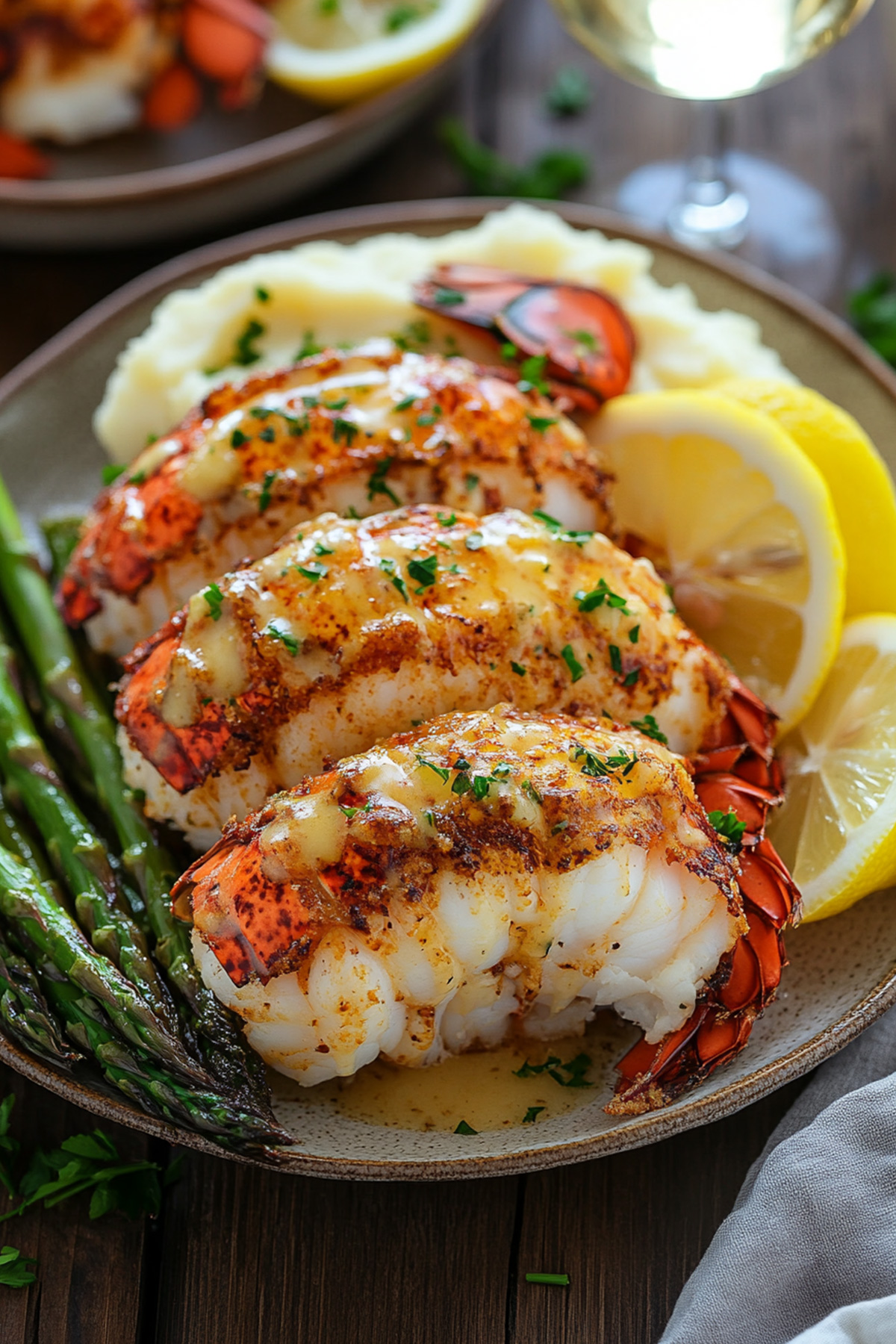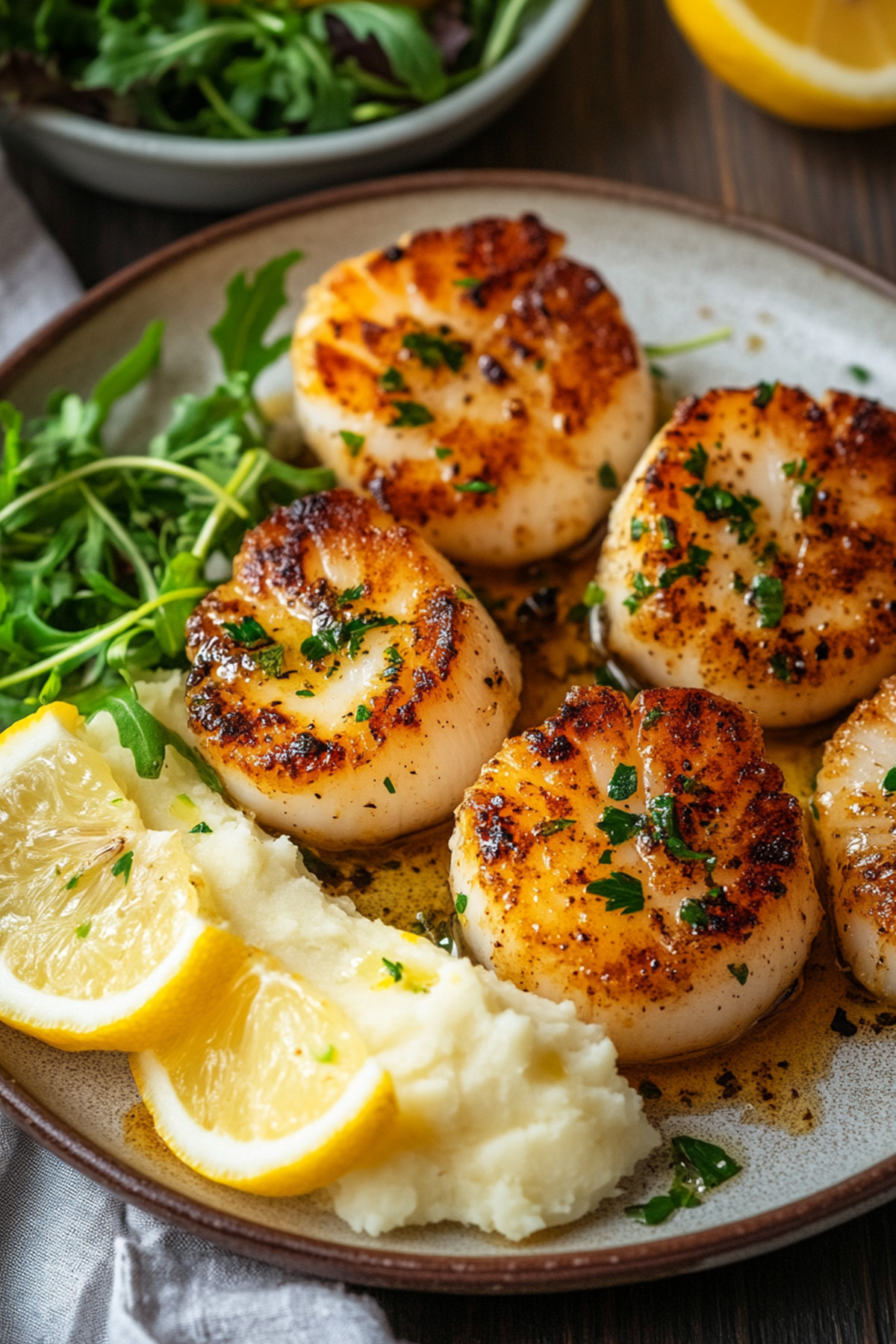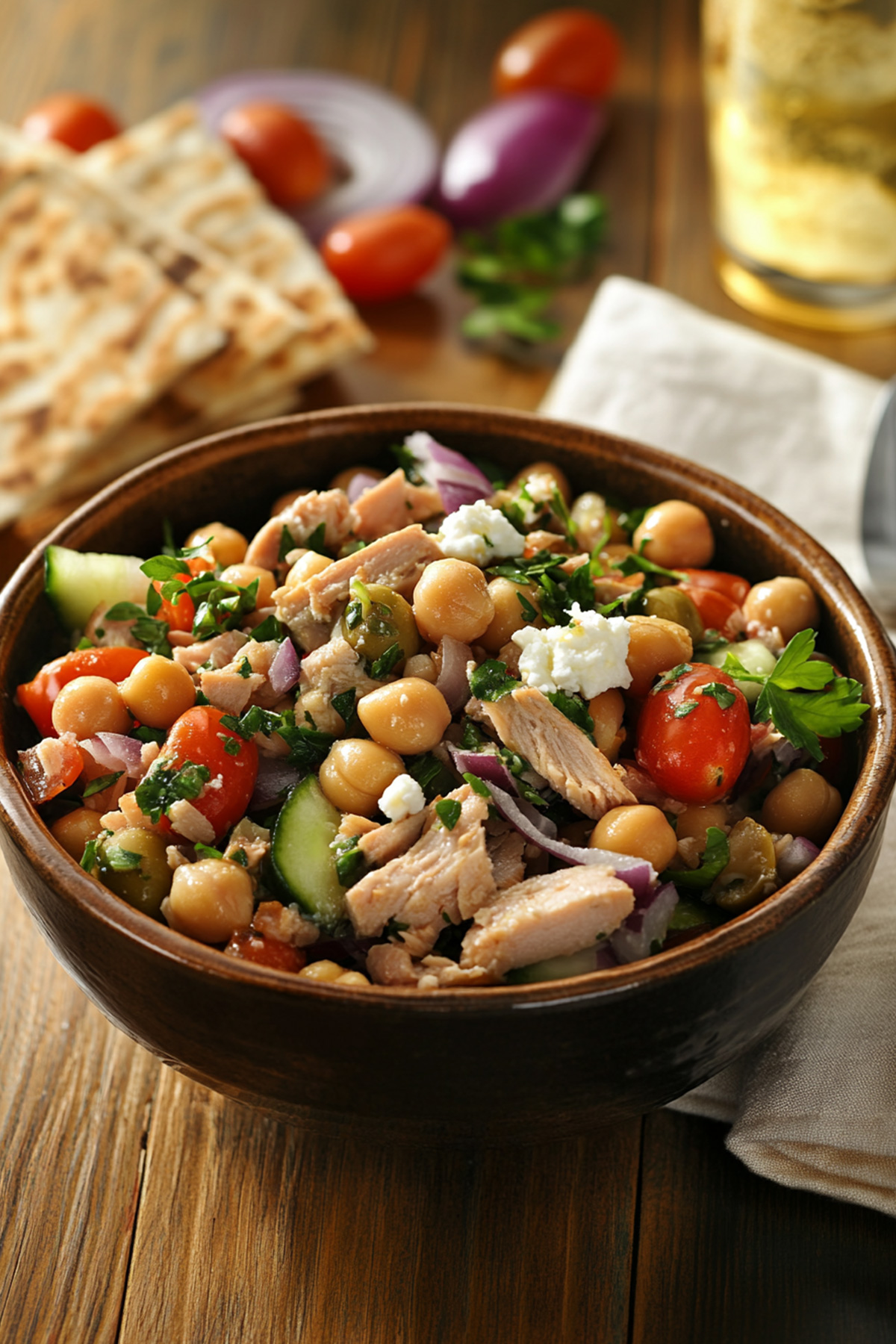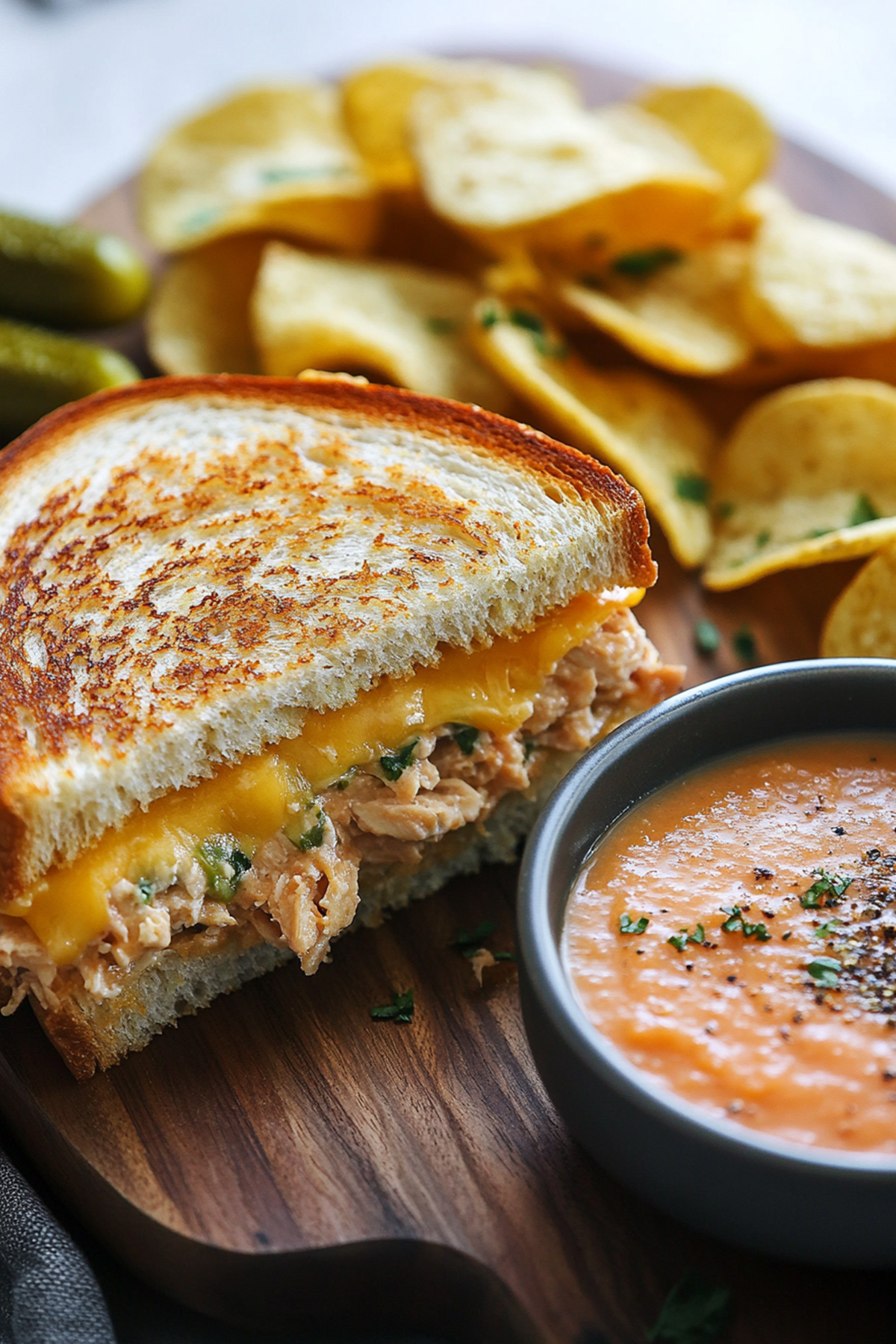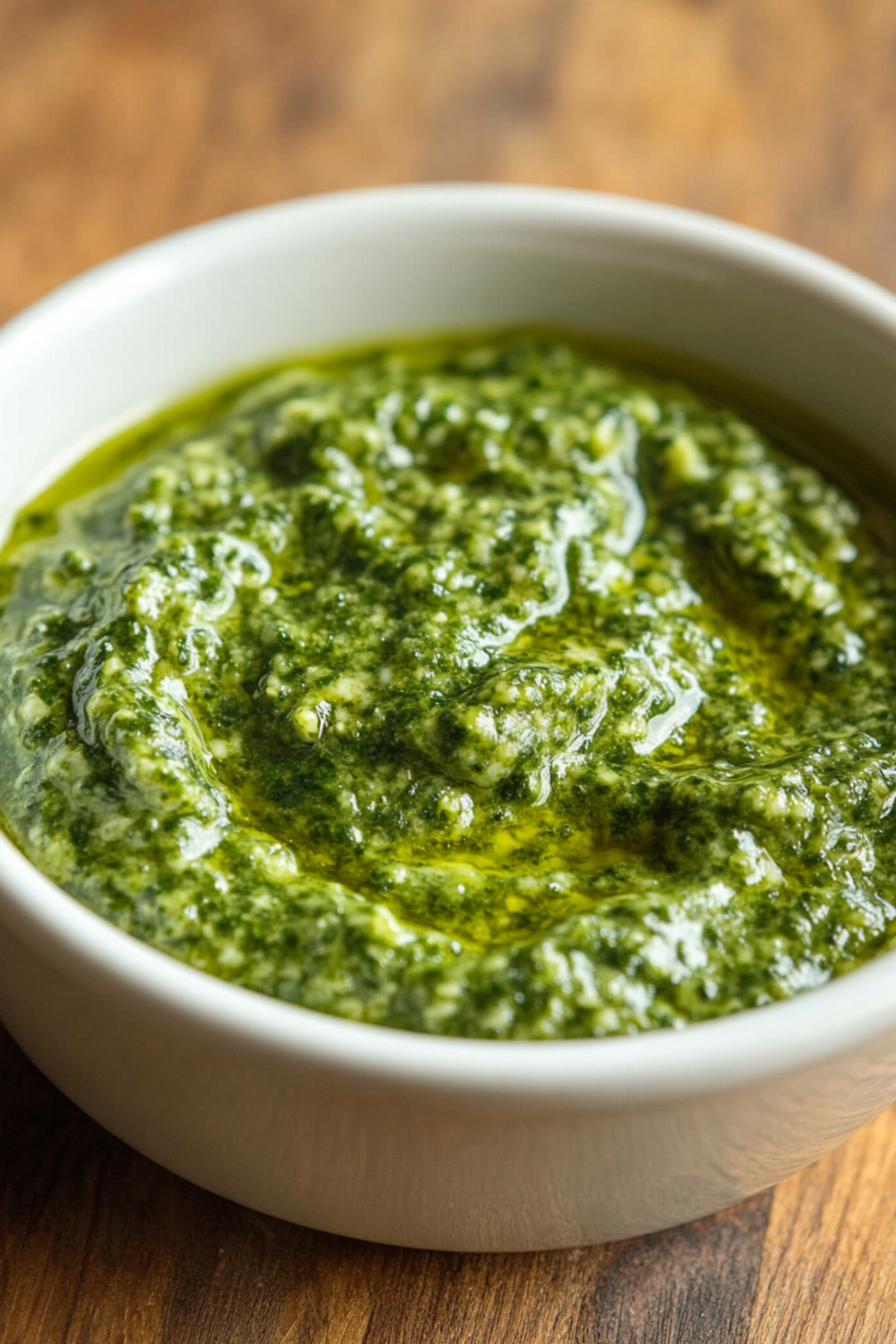Disclosure: As an Amazon Associate and participant in other affiliate programs, we earn from qualifying purchases. We only recommend products we believe will provide value to our readers.
A delicious lobster pasta recipe is easier to make than you might think. The luxurious dish takes just 30 minutes to prepare and is available to any home cook who wants to create a special dinner.
The recipe serves four people generously with either fresh lobster tails or pre-cooked meat. You can split the preparation over two days to build maximum flavor while keeping the cooking process manageable.
Premium ingredients like shallots, garlic, white wine, and cherry tomatoes help create a restaurant-worthy dish in your kitchen.
This detailed guide shows each step to create this decadent pasta dish. You’ll learn everything from selecting the perfect lobster to making the creamy sauce.
Simple ingredients and proper techniques can turn your dinner into an unforgettable culinary experience.
Table of Contents
Why Lobster and Pasta Make the Perfect Combination
Lobster and pasta create a symphony of flavors you won’t find anywhere else. Sweet, succulent lobster meat pairs perfectly with al dente pasta. Each bite brings a balance of textures that delights your palate.
The natural sweetness of lobster meat brings out the subtle wheat notes in pasta. This works best when you toss them in a butter-based or cream sauce.
Your fork finds tender chunks of lobster that contrast beautifully with the firm bite of well-cooked pasta.
This pairing stands out among seafood pasta dishes. Both ingredients work great with other flavors – from fresh herbs’ brightness to garlic-infused butter’s richness.
The pasta soaks up the flavorful sauce while the lobster keeps its distinctive taste. You’ll discover layers of flavor that unfold with every bite.
The combination works with pasta shapes of all kinds. Long, flat noodles like linguine or fettuccine hold onto creamy sauces really well. Shorter shapes like penne or fusilli catch lobster pieces in their ridges and hollows.
Your choice of pasta shape can change how the dish comes together on your fork.
Lobster’s protein-rich meat adds great nutritional value to pasta’s carbohydrate base. You get a satisfying meal that provides lasting energy.
Lobster meat’s natural umami adds depth to any sauce and turns a simple pasta dish into something special.
Simple seasonings and aromatics work well with both ingredients. Garlic, shallots, and fresh herbs bring out the natural flavors while letting lobster shine. A splash of white wine or lemon juice brightens the dish and brings everything together.
The kitchen benefits are practical too. You can time the cooking of both ingredients to finish at the same time. The pasta water becomes your secret ingredient – it helps create a silky sauce that sticks to both noodles and lobster pieces.
Read also: Boiled Lobster Recipe
Choosing the Perfect Lobster for Your Pasta
The quality of lobster you choose will make a huge difference in your pasta dish. You have three main choices: live lobsters, frozen tails, or pre-cooked meat. Each option brings its own benefits to your lobster pasta recipe.
Live lobsters give you the best flavor and texture.
The best ones will curl their tails and move their legs with energy. Their shells should look glossy without any black spots or odd colors.
Lobsters between 1¼ to 1½ pounds are perfect to pasta dishes because of their meat-to-shell ratio.
Frozen tails are a convenient way to go. Here’s what to look for in frozen tails:
- Even shell color without any discoloration
- White meat with red tints, never yellow
- Rock-solid frozen tails without ice crystals
- Packages free from freezer burn
- Uniform size if you’re buying multiple tails
Pre-cooked lobster meat is the most convenient choice, especially to make quick pasta dishes.
If you go this route, buy from trusted seafood vendors and check when it was processed. The meat should be white with slight red edges, firm to touch, and smell fresh like the ocean.
The time of year plays a significant role in your choice. Summer months in North America bring better prices and higher quality lobsters.
But you can find good frozen options all year round to make your pasta dishes.
Tail meat works best in pasta dishes because it stays firm during cooking. You might want to use the sweeter, more tender claw meat as a garnish or mix it into your sauce.
Storage affects when you should buy your lobster.
You need to cook fresh live lobsters the same day you buy them. Frozen tails last up to six months at 0°F (-18°C). Pre-cooked meat needs to go straight into the fridge and you should use it within 2-3 days.
Note that portion size matters when picking your lobster. Plan for 4-6 ounces of meat per serving in your pasta dish. This will give each plate plenty of lobster without overwhelming the pasta.
Read also: Sous Vide Lobster Recipe
The Art of Perfectly Cooking Lobster
Becoming skilled at cooking lobster takes perfect timing and temperature control. We cooked different ways depending on whether you’re using whole lobsters or just the tails for your pasta dish.
Your first step with whole lobsters is to get a large pot of salted water boiling. The lobster goes in headfirst – this will give a quick and humane cooking process. Weight determines cooking time.
A 1-pound lobster needs 8 minutes, while a 1.5-pound one takes 10 minutes.
Signs of perfectly cooked lobster include:
- Shell turning bright red
- Meat changing from translucent to opaque white
- Tail curling naturally
- Antennae pulling out easily
Steaming works best for lobster tails. Set up a steaming rack in a pot with two inches of salted water. The tails should go on the rack once the water boils.
Cover and cook a 4-ounce tail for 5-6 minutes until the meat becomes pearly white.
Temperature control is a vital part of the process.
Your lobster’s internal temperature should hit 140°F (60°C). This is a big deal as it means that 150°F (65°C) makes the meat tough and rubbery. Use a meat thermometer in the thickest part to get it right.
Parboiling is perfect especially when you have pasta dishes in mind. You partially cook the lobster and finish it in the pasta sauce.
Give whole lobsters 3-4 minutes or tails 2-3 minutes in boiling water. The meat should be partly cooked but slightly translucent in the center.
The lobster needs proper handling after cooking too.
A 5-minute rest before cracking helps firm up the meat and makes it easier to remove. Take care while extracting the meat to keep large, attractive pieces that look amazing in your pasta dish.
Pre-cooked lobster meat needs gentle reheating. Add it to your pasta sauce just before finishing. A few minutes of warmth are enough to preserve the meat’s tender texture and sweet flavor.
Read also: Butter Poached Lobster Recipe
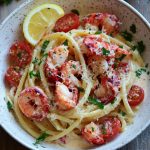
Lobster Pasta Recipe
- Total Time: 30 minutes
- Yield: 4 servings 1x
Description
This simple lobster pasta recipe brings restaurant-quality flavors to your home kitchen. The recipe serves 4 generous portions and takes about 30 minutes to prepare.
Ingredients
- 1 pound bucatini or spaghetti
- 2 lobster tails (4 ounces each)
- 3 tablespoons butter
- 2 cloves garlic, minced
- 2 cups heavy cream
- Cherry tomatoes, halved
- Fresh parsley
- Parmesan cheese
- Salt and pepper to taste
- Optional: paprika to add color and flavor
Instructions
- Bring a large pot of salted water to boil for the pasta. Cook the pasta according to package instructions until al dente. Reserve 1 cup of pasta water before draining.
- The lobster needs a separate pot of boiling salted water. Drop the thawed lobster tails in for 30 seconds per ounce. A 4-ounce tail needs about 2 minutes. The meat should turn white and opaque once cooked.
- Remove the lobster shell and cut the meat into bite-sized pieces. Set it aside while you prepare the sauce.
- Melt butter in a large skillet over medium-high heat and sauté minced garlic for 30-60 seconds. Note that garlic can turn bitter if overcooked.
- Add paprika (if using) and cook for 10 more seconds. Pour in the heavy cream and stir it with the butter and garlic. Add grated parmesan and stir until it melts.
- Add the lobster meat to the sauce and stir gently. Heat the lobster through without overcooking it.
- Mix the cooked pasta with the sauce. Add the reserved pasta water as needed to reach your desired consistency. The starchy pasta water creates a silky, smooth sauce that coats the pasta perfectly.
Notes
- Cook pasta until al dente – it continues to cook in the hot sauce
- Save some pasta water – it’s crucial for the perfect sauce
- Keep an eye on the garlic – it burns quickly
- Add pasta water slowly – you can add more but can’t remove it
- The dish is ready when the sauce evenly coats the pasta and the lobster is hot. Add extra parsley and parmesan if you like. A squeeze of fresh lemon juice brightens up all the flavors.
- Prep Time: 15 minutes
- Cook Time: 15 minutes
- Category: Seafood
- Method: Frying
- Cuisine: Italian
Creating Restaurant-Quality Lobster Pasta Sauce
A silky, flavorful sauce will lift your lobster pasta from good to exceptional. The secret lies in flavor layering and timing your ingredient additions perfectly.
Begin with quality butter and extra virgin olive oil in a wide, heavy-bottomed pan. We used this combination to prevent butter from burning while adding richness to the sauce.
The aromatic base comes from shallots and garlic – cook them until soft but not brown to keep their sweet notes intact.
White wine is a vital part of sauce development. Add it slowly and reduce by half while scraping up the flavorful bits from the pan bottom.
The alcohol cooks away and leaves behind complex depths that improve the lobster’s natural sweetness.
Add heavy cream in small amounts and let each portion mix fully before adding more. This technique keeps the sauce from breaking and creates a smooth, emulsified texture. The secret to that restaurant-quality consistency lies in a gentle simmer rather than a rapid boil.
Temperature control makes or breaks your sauce. High heat will separate the cream, while low heat produces a thin, watery sauce. Keep the flame at medium-low once you add the cream. The sauce should coat a spoon’s back and leave a clear line when you run your finger through it.
Season with care – sea salt and fresh black pepper are foundations, but a pinch of cayenne or paprika adds subtle warmth. Fresh herbs like tarragon or chives complement the lobster’s sweetness without overwhelming it.
Troubleshooting common sauce issues: A thick sauce needs reserved pasta water – its starch maintains the creamy texture. If it’s too thin, simmer until it thickens. Note that the sauce thickens as it cools.
Professional chefs create glossiness and body by mounting the sauce with cold butter. Turn off the heat and whisk in small pieces of butter one at a time.
This creates a smooth, restaurant-worthy finish that perfectly coats both pasta and lobster meat.
Read also: Shrimp with Lobster Sauce Recipe
Wine Pairing with Lobster Pasta
The right wine can boost your lobster pasta’s delicate flavors. A good wine match brings out the lobster’s sweetness and complements the cream sauce perfectly.
White wines make natural partners for lobster pasta dishes. We paired Chardonnay from Burgundy or California because its buttery notes match the cream sauce’s richness.
A crisp Chablis also works well with its mineral undertones that balance the richness while preserving the lobster’s subtle flavors.
Your cream-based lobster pasta pairs great with these wines:
- Unoaked Chardonnay – brings citrus notes without overwhelming
- Pinot Grigio – offers light, refreshing qualities
- Vermentino – adds hints of Mediterranean herbs
- Champagne – provides elegance with fine bubbles
Light-bodied rosés create magic with this dish and add beautiful color contrast to your plate. A Provence rosé delivers subtle berry notes while keeping enough acidity to balance the dish’s richness.
The wine’s temperature makes a big difference in how much you’ll enjoy it. White wines taste best at 45-50°F (7-10°C), and rosés should be slightly cooler. Your wine should feel cool enough to refresh but warm enough to show its full character.
Most people don’t know that some light-bodied red wines work well with lobster pasta, especially with tomato-based sauces.
A gentle Pinot Noir or Beaujolais does the job nicely when served slightly chilled.
Local wine and food combinations often create the best matches. Italian Verdicchio makes a natural match with seafood pasta dishes and brings crisp acidity with subtle almond notes.
French Muscadet’s maritime roots give it minerality that matches the lobster’s ocean-fresh qualities.
Your wine’s acidity should match your sauce. Butter-based sauces need wines with moderate acidity. Tomato-based dishes call for wines with higher acidity to balance the tang.
The occasion helps guide your wine choice. Special celebrations might deserve premium Champagne or aged white Burgundy. Casual dinners pair beautifully with fresh, young wines like Vermentino or Pinot Grigio.
You may also like: Steamed Lobster Recipe
Health Benefits of Lobster Pasta
A well-prepared lobster pasta dish does more than just taste amazing – it packs a serious nutritional punch. We used lobster meat because it gives you high-quality protein without much saturated fat.
You get a perfect mix of nutrients from this combination. The lobster meat has plenty of vitamin B12 that supports your nerve function and helps form red blood cells.
The selenium in lobster works as a great antioxidant and protects your cells from damage.
Whole grain pasta gives you complex carbohydrates that release energy steadily. The fiber helps your digestion and keeps your blood sugar levels stable.
Key nutritional components in lobster pasta include:
- Omega-3 fatty acids from lobster meat
- B-complex vitamins from both ingredients
- Zinc and copper for immune system support
- Iron for oxygen transport
- Magnesium for muscle function
This dish has the perfect protein-to-carbohydrate ratio to help your muscles recover after exercise. Whole grain pasta makes it even better by giving you lasting energy through busy afternoons or evening activities.
Fresh herbs and vegetables add extra nutrition to your lobster pasta. Parsley isn’t just a garnish – it actually has more vitamin C than oranges by weight.
Cherry tomatoes give you lycopene, a powerful antioxidant that’s great for your heart.
The olive oil you use has heart-healthy monounsaturated fats. Garlic and shallots add allicin compounds that boost your immune system.
These ingredients work together to create a meal that’s both delicious and packed with nutrients.
You can adapt lobster pasta to fit different dietary needs. The calories depend on portion size, so it works well with various diet plans.
Switching to whole grain or legume-based pasta adds more fiber and lowers the dish’s glycemic index.
The seafood and dairy products give you calcium for strong bones. Lobster meat’s copper helps form collagen that’s good for your skin and joints. The zinc boosts your immune system and helps wounds heal faster.
References:
– Afishcompany
– WebMD
Nutritional Information
This classic lobster pasta recipe packs a detailed nutritional punch in each standard serving. Here’s what you’ll get in each portion (about 2 cups):
| Nutrient | Amount per Serving |
|---|---|
| Calories | 450-500 |
| Total Fat | 18g |
| Saturated Fat | 8g |
| Cholesterol | 95mg |
| Sodium | 890mg |
| Total Carbohydrates | 48g |
| Dietary Fiber | 2g |
| Protein | 32g |
The macronutrients break down into these ranges:
- Protein: 25-30% of total calories
- Carbohydrates: 40-45% of total calories
- Fat: 30-35% of total calories
A single serving gives you:
- 40% of daily protein requirements
- 35% of daily vitamin B12 needs
- 25% of daily selenium intake
- 20% of daily iron requirements
- 15% of daily calcium needs
The calories can vary depending on your portion size and sauce ingredients. The cream-based sauce adds extra calories and fat, but you can adjust portions or use lighter options to reduce these.
The dish’s sodium content might seem high because of the lobster’s natural saltiness and seasonings. You can cut back on added salt during cooking without losing flavor.
The micronutrients stay consistent no matter how you prepare it. Each serving combines seafood and pasta to meet about 30% of daily caloric needs for someone on a 2,000-calorie diet.
The cholesterol comes from both lobster meat and dairy sauce ingredients. The best way to manage cholesterol intake is through portion control.
Your choice of pasta affects the dish’s glycemic load. Regular semolina pasta has a moderate effect on blood sugar. Whole grain options give you more fiber and slower carb absorption.
The mineral content makes this dish special. Each serving delivers these essential trace elements:
- Magnesium: 15% daily value
- Potassium: 12% daily value
- Phosphorus: 25% daily value
- Zinc: 20% daily value
These nutrition facts help you plan meals and control portions. You can enjoy this luxurious dish while meeting your dietary goals.
References:
– Eat This Much
Conclusion
Lobster pasta combines luxury and simplicity that any home cook can make. The dish might look complex, but you need to focus on three elements to become skilled at making it: quality ingredients, proper cooking techniques, and careful sauce preparation.
The right knowledge about selecting and cooking lobsters will help you create restaurant-worthy results at home.
Quality ingredients and precise timing are crucial – from picking bright-shelled lobsters to getting the perfect sauce consistency.
This impressive dish packs substantial nutrition with protein-rich lobster meat and energy-giving pasta.
A well-paired wine turns your lobster pasta into an unforgettable meal that matches any high-end restaurant’s offering.
Begin with small portions while you practice the technique. Your confidence will grow with the simple steps, and you can try different pasta shapes or sauce variations to create your own version of this classic dish.

